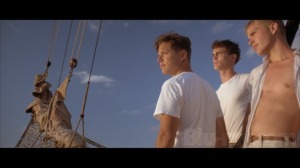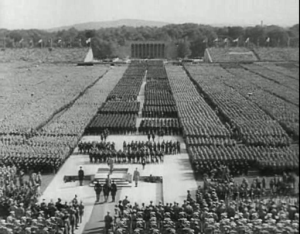Sontag, Star Wars, and Scott – A squib on neo-fascist aesthetics
In 1974, in “Fascinating Fascism,” Susan Sontag wrote:
Triumph of the Will and Olympia are undoubtedly superb films {they may be the two greatest documentaries ever made) , but they are not reaily important in the history of cinema as an art form. Nobody making films today ailudes to Riefenstahl, while many filmmakers ( including myself) regard Dziga Vertov as an inexhaustible provocation and source of ideas about film language.
Funny that she didn’t revise this when it was reprinted in 1980, in Under the Sign of Saturn.
An example:
which might be compared to:
In the 1990s, we can compare this:
 and
and
to just about any shot from Ridley Scott’s White Squall (1996)
 We can compare all of this to Cate Shortland’s Lore (2013), which loves the tiny, the slow, the individual, and hands in contact:
We can compare all of this to Cate Shortland’s Lore (2013), which loves the tiny, the slow, the individual, and hands in contact:
 We might accuse this of being apolitical — our Lore is, after all, a Nazi, and the daughter of an SS officer — but we can take this antimonumentality as a resistance to fascist aesthetics, without its dreams of heroism, redemptive sacrifice, being the “chosen one,” and surviving NATURE by succumbing to some mystical master. Bravo.
We might accuse this of being apolitical — our Lore is, after all, a Nazi, and the daughter of an SS officer — but we can take this antimonumentality as a resistance to fascist aesthetics, without its dreams of heroism, redemptive sacrifice, being the “chosen one,” and surviving NATURE by succumbing to some mystical master. Bravo.


